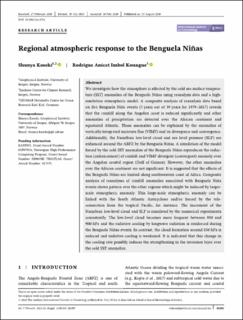Regional atmospheric response to the Benguela Niñas
Journal article, Peer reviewed
Published version

Åpne
Permanent lenke
https://hdl.handle.net/11250/2766162Utgivelsesdato
2021Metadata
Vis full innførselSamlinger
- Geophysical Institute [1228]
- Registrations from Cristin [10402]
Sammendrag
We investigate how the atmosphere is affected by the cold sea surface temperature (SST) anomalies of the Benguela Niñas using reanalysis data and a high-resolution atmospheric model. A composite analysis of reanalysis data based on five Benguela Niña events (5 years out of 39 years for 1979–2017) reveals that the rainfall along the Angolan coast is reduced significantly and other anomalies of precipitation are detected over the African continent and equatorial Atlantic. Those anomalies can be explained by the anomalies of vertically-integrated moisture flux (VIMF) and its divergence and convergence. Additionally, the Namibian low-level cloud and sea level pressure (SLP) are enhanced around the ABFZ by the Benguela Niñas. A simulation of the model forced by the cold SST anomalies of the Benguela Niñas reproduces the reduction (enhancement) of rainfall and VIMF divergent (convergent) anomaly over the Angolan coastal region (Gulf of Guinea). However, the other anomalies over the African continent are not significant. It is suggested that the effects of the Benguela Niñas are limited along southwestern coast of Africa. Composite analysis of reanalyses of rainfall anomalies associated with Benguela Niña events shows pattern over the other regions which might be induced by larger-scale atmospheric anomaly. This large-scale atmospheric anomaly can be linked with the South Atlantic Anticyclone and/or forced by the teleconnection from the tropical Pacific, for instance. The increment of the Namibian low-level cloud and SLP is simulated by the numerical experiments consistently. The low-level cloud becomes more frequent between 950 and 900 hPa and the radiative cooling by longwave radiation is reinforced during the Benguela Niñas events. In contrast, the cloud formation around 850 hPa is reduced and radiative cooling is weakened. It is indicated that this change in the cooling rate possibly induces the strengthening in the inversion layer over the cold SST anomalies.
